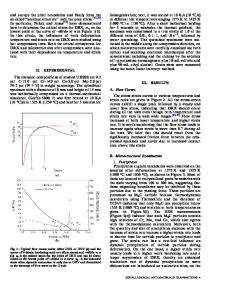Microvoid formation during shear deformation of ultrahigh strength steels
- PDF / 2,364,606 Bytes
- 11 Pages / 590.28 x 785 pts Page_size
- 55 Downloads / 383 Views
II. B A C K G R O U N D
The phenomenon of deformation localization as it occurs in ballistic penetration is illustrated in Figure 1,[2] showing the localized deformation mode of failure, commonly referred to as adiabatic shear. The plastic flow after the onset of shear instability is concentrated in thin shear bands which appear white after metallographic etching. The through-thickness localized flow produces a "shear plugging" failure mode in which the material ahead of the projectile is ejected as a solid piece absorbing relatively little associated energy. Much has been written over the past 40 years on the subject of shear localization. In a recent review, Cowie J.G. C O W l E , Materials Research Engineer, and M. AZRIN, Supervisory Metallurgist, are with the U.S. A r m y Materials Technology Laboratory, Watertown, M A 02172-0001. G.B. O L S O N is Professor at Northwestern University, Evanston, IL 60208. Manuscript submitted March 28, 1988. METALLURGICAL TRANSACTIONS A
and Tuler t3] describe the various modeling approaches: flow softening, deformation heating, textural softening, and void nucleation softening. The review also describes the relationship between shear instability and fracture toughness. The reviews of Rogers t4,51 and Bedford e t al.E6] give an excellent overview of the general phenomenon including the microstructures resulting from localized flow. The continuum plasticity theory of adiabatic flow localization is treated by Clifton, ~7~and a general survey of strain localization is given by Argon. t81 A concise treatment of the specific role of adiabatic shear in armaments and ballistics can be found in the review of Samuels and Lamborn. m~ Olson e t al. ~1~ endeavored to computer model the ballistic penetration of high strength steel using experimentally derived constitutive flow relations, but met with limited success. The authors proposed that the material exhibited a pressure dependence that the conventional thermal softening models could not describe. Experiments were designed to determine how the pressure dependence affects the deformation of UHS steels. More recent research by Azrin e t a l . tIJ showed that the critical strain for shear localization in high strength 4340 steel is nearly identical for both isothermal (quasistatic) and adiabatic (dynamic) loading conditions. While thermal softening undoubtedly provides a contribution to the measured stress-strain relations, ihis result of nearly identical instability strains and shear localization behavior in UHS steels at both high and low strain rates indicated that another flow softening phenomenon was equally important. As was reviewed in Reference 10, observations that the instability strain is strongly influenced by the hydrostatic component of stress, together with metallographic evidence of microvoid nucleation, indicate that fracture related processes can also contribute to the strain softening effects underlying plastic shear localization, t11,12,~3] Such phenomena must also be taken into account for a complete understanding of
Data Loading...











